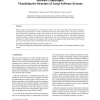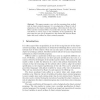JOT
2010
14 years 5 months ago
2010
Abstract We propose a dependence-based representation for object-oriented programs, named Call-based Object-Oriented System Dependence Graph (COSDG). Apart from structural features...
ENTCS
2002
14 years 7 months ago
2002
In this paper we present how refactoring of object-oriented programs can be accomplished by using refinement. Our approach is based on algebraic laws of an object-oriented languag...
JSS
2008
14 years 7 months ago
2008
The high cost of software maintenance could be reduced by automatically improving the design of object-oriented programs without altering their behaviour. We have constructed a so...
VISSYM
2004
14 years 8 months ago
2004
Modern object-oriented programs are hierarchical systems with many thousands of interrelated subsystems. Visualization helps developers to better comprehend these large and comple...
FMOODS
2008
14 years 8 months ago
2008
Reasoning about object-oriented programs is hard, due to , dynamic binding and the need for data abstraction and framing. Reasoning about concurrent object-oriented programs is eve...
ECOOP
1995
Springer
14 years 10 months ago
1995
Springer
Previous studies have shown that object-oriented programs have different execution characteristics than procedural programs, and that special object-oriented hardware can improve p...
GECCO
2006
Springer
14 years 10 months ago
2006
Springer
Encapsulation of states in object-oriented programs hinders the search for test data using evolutionary testing. As client code is oblivious to the internal state of a server obje...
EUROGP
2004
Springer
14 years 11 months ago
2004
Springer
Most programs currently written by humans are object-oriented ones. Two of the greatest benefits of object oriented programming are the separation of interface from implementation,...
AMAST
2004
Springer
14 years 11 months ago
2004
Springer
This paper presents a new rule for reasoning about method calls in object-oriented programs. It is an adaptation of Hoare's rule of adaptation to the object-oriented paradigm,...
PLDI
1994
ACM
14 years 11 months ago
1994
ACM
: Object-oriented programs are difficult to optimize because they execute many dynamically-dispatched calls. These calls cannot easily be eliminated because the compiler does not k...





